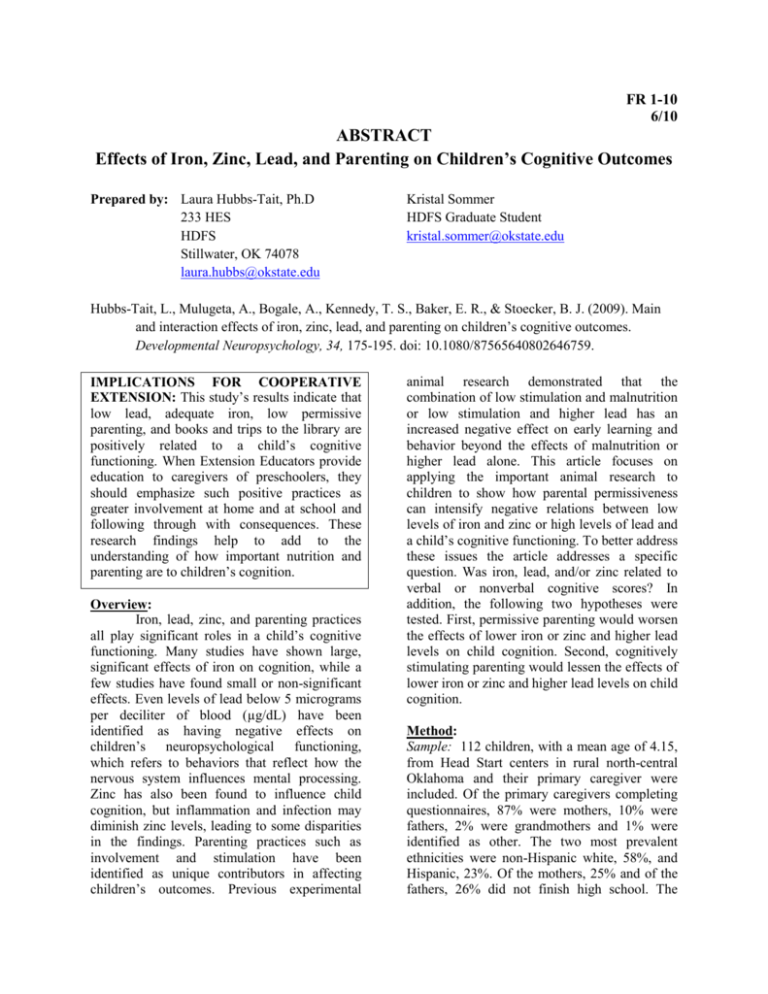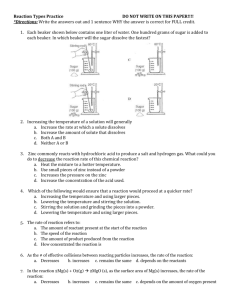Effects of Iron, Zinc, Lead and Parenting on Children`s Cognitive
advertisement

FR 1-10 6/10 ABSTRACT Effects of Iron, Zinc, Lead, and Parenting on Children’s Cognitive Outcomes Prepared by: Laura Hubbs-Tait, Ph.D 233 HES HDFS Stillwater, OK 74078 laura.hubbs@okstate.edu Kristal Sommer HDFS Graduate Student kristal.sommer@okstate.edu Hubbs-Tait, L., Mulugeta, A., Bogale, A., Kennedy, T. S., Baker, E. R., & Stoecker, B. J. (2009). Main and interaction effects of iron, zinc, lead, and parenting on children’s cognitive outcomes. Developmental Neuropsychology, 34, 175-195. doi: 10.1080/87565640802646759. IMPLICATIONS FOR COOPERATIVE EXTENSION: This study’s results indicate that low lead, adequate iron, low permissive parenting, and books and trips to the library are positively related to a child’s cognitive functioning. When Extension Educators provide education to caregivers of preschoolers, they should emphasize such positive practices as greater involvement at home and at school and following through with consequences. These research findings help to add to the understanding of how important nutrition and parenting are to children’s cognition. Overview: Iron, lead, zinc, and parenting practices all play significant roles in a child’s cognitive functioning. Many studies have shown large, significant effects of iron on cognition, while a few studies have found small or non-significant effects. Even levels of lead below 5 micrograms per deciliter of blood (µg/dL) have been identified as having negative effects on children’s neuropsychological functioning, which refers to behaviors that reflect how the nervous system influences mental processing. Zinc has also been found to influence child cognition, but inflammation and infection may diminish zinc levels, leading to some disparities in the findings. Parenting practices such as involvement and stimulation have been identified as unique contributors in affecting children’s outcomes. Previous experimental animal research demonstrated that the combination of low stimulation and malnutrition or low stimulation and higher lead has an increased negative effect on early learning and behavior beyond the effects of malnutrition or higher lead alone. This article focuses on applying the important animal research to children to show how parental permissiveness can intensify negative relations between low levels of iron and zinc or high levels of lead and a child’s cognitive functioning. To better address these issues the article addresses a specific question. Was iron, lead, and/or zinc related to verbal or nonverbal cognitive scores? In addition, the following two hypotheses were tested. First, permissive parenting would worsen the effects of lower iron or zinc and higher lead levels on child cognition. Second, cognitively stimulating parenting would lessen the effects of lower iron or zinc and higher lead levels on child cognition. Method: Sample: 112 children, with a mean age of 4.15, from Head Start centers in rural north-central Oklahoma and their primary caregiver were included. Of the primary caregivers completing questionnaires, 87% were mothers, 10% were fathers, 2% were grandmothers and 1% were identified as other. The two most prevalent ethnicities were non-Hispanic white, 58%, and Hispanic, 23%. Of the mothers, 25% and of the fathers, 26% did not finish high school. The median household income was between $12,000 and 17,988 per year, markedly below the median household income of $35,831 for the sampled area. Measures: Primary caregivers completed the Demographic Information Questionnaire (DIQ) and the Home Practices Questionnaire (HPQ), which collected information on demographic variables, parenting practices, and the amount of cognitive stimulation conducted in the home environment. Children’s verbal and non-verbal cognition was assessed using the McCarthy Scales of Children’s Abilities (MSCA) with the Peabody Picture Vocabulary Test-III (PPVT-III) measuring receptive vocabulary. Blood samples were collected to measure lead, zinc, and iron levels. Results: For the first question, lead and iron were significantly correlated with children’s cognitive outcomes; zinc was not. Higher lead levels were linked to lower MSCA perceptual scores, whereas lower iron levels were linked to lower PPVT-III and MSCA verbal scores. These relationships were significant even with cognitive stimulation in the home controlled (books, trips to the library). As hypothesized permissive parenting did worsen the effects of lead relating to children’s perceptual scores and iron relating to children’s PPVT-III scores. However, neither measure of cognitive stimulation, number of children’s books in the home and frequency of trips to the library, interacted with lead or iron in predicting children’s scores. Discussion: One significant finding from this study was that iron levels predicted children’s verbal scores on the PPVT-III and the MSCA verbal scale above and beyond the 15% of the variance in these scores that could be attributed to number of books in children’s homes and trips to the library. Perceptual scores on the MSCA were found to be negatively predicted by lead levels, which supports previous research. Furthermore, parents who scored low on the permissive parenting scale tended to be more involved with their children, did not spoil them, and followed through with consequences. These characteristics were found to protect against the negative outcomes of higher lead levels and lower iron levels. Lastly, it is important to note other reasons why parental permissiveness parents might have exacerbated the effects of high lead and low iron. In previous research high permissive parents provided lower social and emotional support and provided and modeled poorer nutrition choices.







